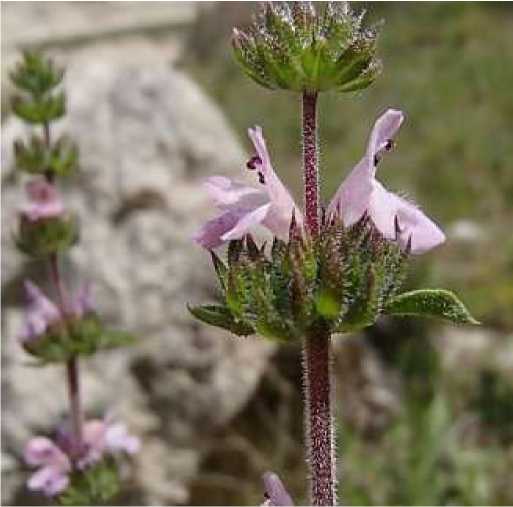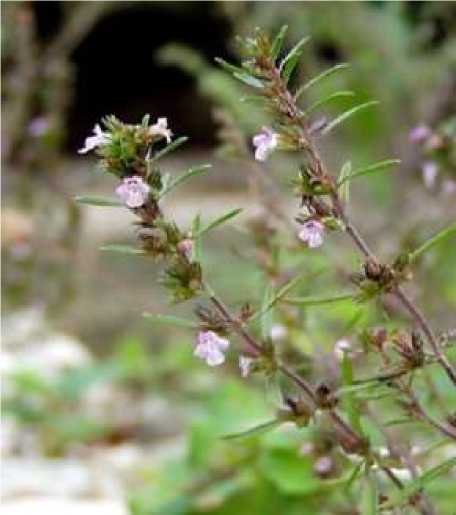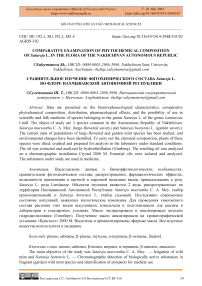Comparative examination of phytochemical composition of Satureja L. in the flora of the Nakhchivan Autonomous Republic
Автор: Suleymanova Sh.
Журнал: Бюллетень науки и практики @bulletennauki
Рубрика: Биологические науки
Статья в выпуске: 6 т.10, 2024 года.
Бесплатный доступ
Data are presented on the biomorphoecological characteristics, comparative phytochemical composition, distribution, pharmacological effects, and the possibility of use in scientific and folk medicine of species belonging to the genus Satureja L. of the genus Lamiaceae Lindl. The object of study are 2 species common in the Autonomous Republic of Nakhchivan: Satureja macrantha C. A. Mey. (large-flowered savory) and Satureja hortensis L. (garden savory). The current state of populations of large-flowered and garden mint species has been studied, and environmental changes have been identified. To carry out the chemical composition, plants of these species were dried, crushed and prepared for analysis in the laboratory under standard conditions. The oil was extracted and analyzed by hydrodistillation (Ginsberg). The resulting oil was analyzed on a chromatographic installation Crystal 2000 M. Essential oils were isolated and analyzed. The substances under study are used in medicine.
Pinene, sabinene, β-pinene, myrcene, α-terpinene, β-ocimene, linalool
Короткий адрес: https://sciup.org/14130169
IDR: 14130169 | УДК: 581.192.1, | DOI: 10.33619/2414-2948/103/02
Текст научной статьи Comparative examination of phytochemical composition of Satureja L. in the flora of the Nakhchivan Autonomous Republic
Бюллетень науки и практики / Bulletin of Science and Practice
UDC 581.192.1, 581.192.2, 581.4
The main objective of the study was Satureja macrantha C. A. Mey. — Irrigation of wild mint and Satureja hortensis L. — Chromatographic detection of biologically active substances in fragrant (garden) wild mint species and identification of prospects for medical use.
Materials and Methods
The research work was carried out on Satureja hortensis L. — Fragrant field mint and Satureja macrantha C. A. May — Large-flowered field mint in an independent experimental field. Reproduction of studied species G. I. Zaytsev [1], morphological features of vegetative organs I. E. Serebryakov [2], growth and development dynamics were performed based on the methods proposed by A. A. Molchanov and V. Smirnov [3].
In our study, the species was propagated by stem division and burial method with good care. In order to carry out the work, 7-10 cm long sections were cut from fragrant and large-flowered wild mint plants that brought from the field in September-October. The cut sections were buried at a depth of 5-6 cm under greenhouse conditions and irrigation was carried out. From time to time, the air in the greenhouse was changed and heated as needed. In the 1st decade of April, the revived sections have already developed and reached a height of 11-12 cm. It has been found that slightly humus, sandy and gravelly soils are considered a favorable environment for the species. In shady conditions, the essential oil content of the leaves and branches of the plant decreases. The species is demanding of nitrogen, phosphorus and potassium fertilizers. In our research, the leaves and stems of the studied species were analyzed by chromatography.
Discussion
Proper use of plant resources is one of the important issues for and sustainable use of biodiversity. Satureja macrantha C. A. Mey to conduct research in this direction. Wild rainbow mint and Satureja hortensis L. — It is important to study the current state of fragrant (garden) wild mint species, to identify ecological and anthropogenic transformations both theoretically and experimentally [1, 4, 5].
There is a great need for a broader study of biomorphological, ecological patterns of distribution, phytochemical composition, study of therapeutic, scientific, folk and traditional aspects of species belonging to this genus in the flora of the Nakhchivan Autonomous Republic. For this purpose, studies of species belonging to this genus were carried out. The names and systematic features of the species are given in accordance with the modern system (APG) [6].
Investigated Satureja macrantha C. A. Mey. — Large mint and Satureja hortensis L. — A detailed study of biologically active substances in fragrant (garden) wild mint species is considered very relevant for the further use of its substances, especially in scientific medicine.
It was from this point of view that these species were studied mainly according to the method of G. Serebryakov [2]. First of all, we will give brief information about the botanical features of these species.
Genus: Satureja L.
Satureja macrantha C. A. May. — Large-flowered field mint.
Large-flowered field mint is an annual plant. The stem is numerous, thin, woody at the base, simple or sparsely branched, and the height is 30-50 cm. The leaves are numerous, lobed, linear-glossy or oblong-glossy, blunt. Peony flowers have 1-3 flowers, are soft, and are collected in a spike flower group. The calyx is tubular-bell-shaped, 5 mm long, bilobed, with a bevel-shaped tooth 3 times shorter than the tube, and the lower 2 teeth are slightly longer. The corolla is 12-15 mm long, pink, long tubular, narrow, slightly longer than the calyx. The stamen is longer than the corolla. Hazel fruits are 1.5 mm long, egg-shaped and grayish in color (Figure 1). It blooms in June-August and bears fruit in July-September [7-9].
Spread in the forest and shrub regions of the Nakhchivan Autonomous Republic, on rocky slopes and in areas up to the mid-mountain belt, both individually and as part of phytocenosis [9, 10].
Experimental part: Satureja macrantha C. A. Mey as an object of study — Iridescent wild mint and Satureja hortensis L. — Fragrant (horticultural) wild mint plants are dried and ground separately under standard conditions. Essential oil was obtained from plants by hydrodistillation (Ginsberg).
Results and their discussion
According to the results of chromatographic analysis, originally Satureja macrantha C. A. Mey. — The composition of mint iris flowers was analyzed in Crystal 2000 M gas chromatography. Morphological features of the vegetative organs of these species were carried out according to the method of I. G. Serebryakova [2]. The results of phytochemical analysis are shown in the following Table 1.
RESULTS OF CHROMATOGRAPHY OF Satureja macrantha SPECIES
Table 1
Satureja hortensis L. Fragrant (Garden) field mint — is an annual plant, a species of the genus Satureja L. (Figure 2).

Figure 1. Satureja macrantha C. A. Mey.

Figure 2. Satureja hortensis L.
It grows on dry gravelly and stony slopes and rocks. It is grown for decorative purposes in gardens and gardens. It is 10-15 cm long, with a thin root, flat, almost cylindrical shape. The stem is 15-30 cm long, including the leaf, and is branched from the base. The branches consist of short and stiff hairs. The leaves are linear or lanceolate, 1.5-2.5 cm long. Wreath-shaped flowers are purple, light purple or pink in color. The fruit is a nut, naked and egg-shaped [9].
Blooms in July-October. Vegetable oil contains tannins and resins. The composition of essential oils varies with plant growth. During the maximum collection, the essential oil has a pungent odor reminiscent of the smell of thyme and is a light-yellow liquid. The oil contains 3042% hydrocarbons, n-symols and up to 40% triterpene hydrocarbons. This plant has a strong aroma, pleasant taste and spice. Fresh and dried leaves are used as a spice for pickling cucumbers and tomatoes, seasoning for food.
This plant is used in the preparation of legumes, mushrooms (except champignons), meat and potato salads, boiled fish, fried herring, soups, mayonnaise, minced meat, steaks, meatballs, sausages, fried potatoes, stews, cheeses, croutons and salted biscuits.
In the pharmaceutical industry, it is mainly used for the production of oils, medicinal teas and tinctures. In clinical studies, mountain mint is also used as an astringent for gastrointestinal diseases, as a strengthening bath for stomach cramps. In Bulgarian folk medicine, the ore is used as a diuretic, diaphoretic, remedy for tachycardia, migraine, appetite suppressant, antiseptic, bactericidal and antispasmodic.
The results of the chromatographic analysis of Satureja hortensis L. — aromatic (garden) species of wild mint are shown in the following Table 2.
Table 2
RESULTS OF CHROMATOGRAPHY OF Satureja hortensis SPECIES
|
Time, minutes |
Detected component |
Area, % |
|
6.746 |
α-Pinen |
0.098 |
|
7.433 |
β-Pinen |
2.313 |
|
8.721 |
sabinene |
0.074 |
|
10.854 |
carene 3 |
0.411 |
|
10.888 |
α-terpinene |
0.036 |
|
11.045 |
1,8 cineole (eucalyptol) |
0.281 |
|
13.557 |
µ-terpinene |
0.389 |
|
13.822 |
tetrahidro-2H-pyran |
0.020 |
|
14.765 |
terpinolene |
0.073 |
|
14.876 |
cyclohexanone, 5-methyl-2-(1-methylethyl)-, cis- |
0.041 |
|
15.011 |
caryophyllene |
6.797 |
|
15.098 |
terpinen-4-ol |
0.073 |
|
15.324 |
bromil acetate |
0.330 |
|
16.233 |
citronellol |
0.070 |
|
16.367 |
Estragole |
0.241 |
|
16.429 |
camphene |
0.223 |
|
16.588 |
myrtenol |
0.300 |
|
16.744 |
nerol |
0.333 |
|
17.088 |
geraniol |
0.260 |
|
17.564 |
camphor |
0.035 |
|
18.362 |
citronellyl butyrate |
0.014 |
|
19.777 |
α-terpinyl acetate |
0.116 |
|
19.843 |
geranyl oleate |
0.026 |
|
20.888 |
neryl acetate |
0.009 |
|
20.991 |
citronellyl tiglate |
0.007 |
|
20.998 |
cedrol |
0.093 |
|
20.998 |
2-phenil ethyl tiglate |
0.204 |
According to the results of the analysis of Satureja hortensis L. — Wild aromatic (garden) mint contains not less than 0.007% citronellyl tiglate and not more than 6.797% caryophyllene. The abundance of this substance helps to strengthen the body’s immunity and makes the body more resistant to disease.
In folk medicine, the infusion is used for fever, diseases of the liver, stomach and spleen (splenomegaly). Freshly squeezed juice mixed with alcohol is used for insomnia, as an antifungal, antibacterial and healing method. In Central Asian folk medicine, an infusion of flowers is used for ulcerative colitis, haemorrhoids, inflammatory processes in the appendix (appendicitis), bad breath, epilepsy and a number of other diseases. Prolonged use of this plant can cause anemia. Overdose causes hallucinations, nausea, vomiting and intestinal disorders. Mint mountain large is used for the prevention and treatment of varroatosis of bees. Both species are grown as ornamental garden plants. Both species enrich the atmosphere with oxygen, and all their organs are used in different forms in the treatment of various diseases [4, 7, 9].
Results
-
1 . Satureja macrantha C. A. Mey. — At least 0.014% of tetrahydro-2H-pyran and not more than 41.455% of caryophyllene, vitamins C and E were found in varieties of large mint.
-
2. Satureja hortensis L. — Fragrant (garden) wild mint contains not less than 0.007% citronellyl tiglate and not more than 6.797% caryophyllene. Caryophyllene, which is abundant in both types, strengthens the immune system. Thus, it makes the body resistant to diseases.
-
3. In folk medicine, the infusion is used for fever, diseases of the liver, stomach and spleen, fresh juice is used for insomnia, as an antifungal, antibacterial and healing remedy. It is used for inflammatory bowel disease (appendicitis), bad breath and epilepsy.
-
4. Both species are grown for decorative purposes.
Список литературы Comparative examination of phytochemical composition of Satureja L. in the flora of the Nakhchivan Autonomous Republic
- Зайцев Г. Н. Фенология древесных растений. М.: Наука, 1981. 120 с.
- Серебряков И. Г. Морфология вегетативных органов высших растений. М.: Сов. наука, 1952. 392 с.
- Молчанов А. А., Смирнов В. В. Методика изучения прироста древесных растений. М.: Наука, 1967. 95 с.
- Ələkbərov R. Ə. Naxçıvan Muxtar Respublikası florasında yayılan Dalamazkimilər (Lamiaceae Lindl.) fəsiləsinin Satureja L. (Çöl nanəsi) cinsinə daxil olan növlərin biomorfoekoloji və müalicəvi xüsusiyyətləri. Naxçıvan Bölməsinin Xəbərləri, Təbiət və texniki elmlər seriyası, 2014. №4. S. 115-119.
- Дамиров И. А., Прилипко Л. И., Шукюров Д. З., Керимов Ю. Б. Лекарственные растения Азербайджана (используемые в научной, народной медицине и перспективные для детальных исследований). Баку: Маариф, 1982. 319 с.
- Мехтиева Н. П. Биоразнообразие лекарственных растений флоры Азербайджана: автореф. дис.. д-р биол. наук. Баку, 2015. 44 с.
- Мустафаева И. Р., Ибадуллаева С. С., Алекперов Р. А., Исмайлов А. Х., Гасымов Х. З., Гасымова Ш. Ш. Фармакогнозия с основами ботаники. Нахчыван: Аджами, 2015. 648 с.
- Ибадуллаева С. Д., Алекперов Р. А., Гасымов Г. З. Thymus hyemalis (Lamiaceae)-новый вид для флоры Азербайджана // Ботанический журнал. 2014. Т. 99. №7. С. 825-827. EDN: SHFISD
- Карягин И. И. Флора Азербайджана. Баку: Изд-во Акад. наук АзССР. Т. 8. 1953. 403 с.
- Задорожный А. М. Справочник по лекарственным растениям. М.: Лесн. пром-сть, 1988. 411 с.


